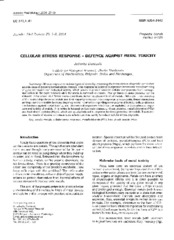Приказ основних података о документу
Ćeluski odgovor na stres - odbrana od toksičnih efekata metala
Cellular stress response: Defence against metal toxicity
| dc.creator | Dunđerski, Jadranka S. | |
| dc.date.accessioned | 2017-02-17T14:51:36Z | |
| dc.date.available | 2017-02-17T14:51:36Z | |
| dc.date.issued | 2004 | |
| dc.identifier.issn | 0354-3447 | sr |
| dc.identifier.other | Rad_konverzija_116 | sr |
| dc.identifier.uri | https://radar.ibiss.bg.ac.rs/handle/123456789/30 | |
| dc.description.abstract | All cells respond to various types of stress by increasing the transcription of specific genes that encode class of proteins termed stress proteins. This response is believed to represent a transient reprogramming of gene expression and biological activity, which serves to protect sensitive cellular components from damage, and assists in the rapid recovery after the stress is removed or ceases. The synthesis of stress proteins can be induced under a host of different stress conditions, including elevated level of metals. Although, understanding of the relationships between metals and their capacity to induce stress response is incomplete, these interactions are important to consider because they may reveal information regarding mechanisms of toxicity, cellular defense mechanisms against metal toxicity, and biochemical responses which can be exploited as biomarkers of exposure and toxicity of metals. This review is focused on two main classes of stress proteins, metallothioneins (MTs) and heat shock proteins (Hsps), which are usually induced in response to stress provoked by metals. It summarizes the results of studies on metals toxic effects and their ability to induce cellular stress response. | en |
| dc.description.abstract | Sve žive ćelije odgovaraju na različite tipove stresa povećavanjem transkripcije specifičnih gena koji kodiraju klasu proteina nazvanih stres proteini. Taj odgovor predstavlja prolazno reprogramiranje ekspresije gena i biološke aktivnosti, i služi da zaštiti osetljive ćelijske komponente od oštećenja, i pomogne u brzom oporavku posle uklanjanja ili prestanka delovanja stresa. Sinteza proteina stresa može biti indukovana pod delovanjem različitih stresogenih uslova, uključujući i povećani nivo metala. Pošto je razumevanje odnosa između metala i njihovog kapaciteta da indukuju odgovor na stres nedovoljno poznato, njihovo proučavanje je važno zato što može dati informacije o mehanizmima toksičnosti metala, ćelijskim odbrambenim mehanizmima i biohemijskim odgovorima koji se mogu koristiti kao biomarkeri izlaganja ili toksičnosti metala. Ovaj revijski članak je fokusiran na dve klase stres proteina, metalotioneina (MT) i proteina toplotnog stresa (Hsp), koje se najčešće indukuju u odgovoru na stres provociran metalima. Sumirani su rezultati istraživanja toksičnih efekata metala i njihove sposobnosti da indukuju ćelijski odgovor na stres. | sr |
| dc.language.iso | eng | sr |
| dc.rights | openAccess | sr |
| dc.source | Jugoslovenska medicinska biohemija | sr |
| dc.subject | metali | SRP |
| dc.subject | metals | ENG |
| dc.subject | ćelijski odgovor na stres | SRP |
| dc.subject | cellular stress response | ENG |
| dc.subject | metalotioneini (MT) | SRP |
| dc.subject | metallothionein (MT) | ENG |
| dc.subject | heat shock protein (Hsp) | ENG |
| dc.subject | proteini toplotnog stresa (Hsp) | SRP |
| dc.title | Ćeluski odgovor na stres - odbrana od toksičnih efekata metala | sr |
| dc.title | Cellular stress response: Defence against metal toxicity | en |
| dc.type | article | sr |
| dc.rights.license | ARR | |
| dcterms.abstract | Ћелуски одговор на стрес - одбрана од токсичних ефеката метала; Дунђерски, Јадранка С. | |
| dc.citation.issue | 1 | sr |
| dc.citation.volume | 23 | sr |
| dc.citation.spage | 1 | sr |
| dc.citation.epage | 9 | sr |
| dc.type.version | publishedVersion | sr |
| dc.identifier.fulltext | https://radar.ibiss.bg.ac.rs//bitstream/id/2754/Rad_konverzija_116.pdf | |
| dc.citation.rank | M23 | |
| dc.identifier.rcub | https://hdl.handle.net/21.15107/rcub_ibiss_30 |

